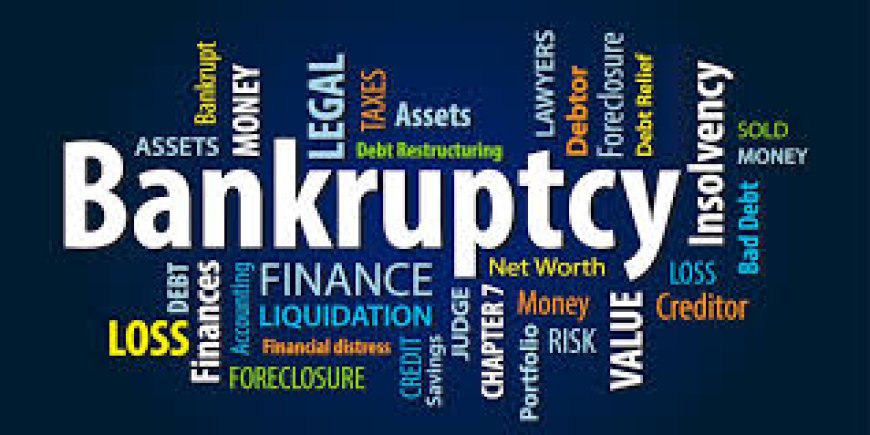Managing Bankruptcy in Business: A Comprehensive Guide
Bankruptcy is a legal process for companies unable to repay debts. There are three main forms: Chapter 7 (liquidation), Chapter 11 (reorganization), and Chapter 13 (wage earner's plan). Common triggers for bankruptcy include financial challenges (e.g., cash flow problems), operational problems (e.g., poor management), and external influences (e.g., economic downturn). Filing for bankruptcy involves assembling documentation, hiring professionals, and submitting petitions to court. Once filed, an automatic stay prevents creditors from collection actions. A trustee oversees the proceedings and reviews financial affairs. Court hearings may be held. Businesses usually continue operating under a trustee's supervision during bankruptcy. Cost-cutting measures, new financing, and strategic partnerships may aid survival. Negotiations with creditors are crucial. Post-bankruptcy rebuilding involves restoring credit, rebranding and marketing, diversifying revenue, and maintaining financial discipline. Tips for Success: * Seek prompt professional advice. * Be transparent with creditors. * Explore available options. * Negotiate aggressively. * Commit to post-bankruptcy recovery. Understanding bankruptcy and managing it effectively is essential for maximizing recovery and minimizing losses for businesses facing financial distress.

Managing Bankruptcy in Business: A Comprehensive Guide
Introduction
Business bankruptcy is a legal process that occurs when a company is unable to repay its outstanding business debts. This occurs under the guidance and protection of the bankruptcy court, allowing businesses to either eliminate or repay their debts.
Bankrupt is not the only legal status that an insolvent person may have, and the term bankruptcy is therefore not a synonym for insolvency.
Bankruptcy is a challenging and complex situation that can significantly impact businesses and individuals alike. For businesses facing financial distress, understanding the bankruptcy process and managing it effectively is essential for maximizing recovery and minimizing losses. This comprehensive guide provides a detailed overview of how to navigate bankruptcy in business. As you navigate the complex landscape of bankruptcy code, it's vital to recognize the different types and their implications:
3 Main Forms Of Business Bankruptcy
- Chapter 7: This type of bankruptcy, also known as liquidation, involves the sale of business assets. The proceeds from the sale are used to pay off creditors. Typically, businesses with little chance of recovery opt for Chapter 7 bankruptcy. The Bank of New England Corporation was a regional banking institution based in Boston, Massachusetts, which was seized by the Federal Deposit Insurance Corporation (FDIC) in 1991 as a result of heavy losses in its loan portfolio and was placed into Chapter 7 liquidation.
- Chapter 11: Also referred to as reorganization, Chapter 11 bankruptcy enables businesses to restructure their business debts and continue operating. This option is suitable for businesses with a strong possibility of financial recovery. There are two subcategories of Chapter 11 bankruptcy—small business cases and subchapter V, specifically designed to cater to small business owners. Some companies that have filed for this type of bankruptcy include Bally Sports San Diego, AHS Sherman Medical Center, AeroFarms, etc.
- Chapter 13: Chapter 13 bankruptcy, often called a "wage earner's plan," is typically used by individuals and sole proprietors. It allows businesses to create a repayment plan to pay off their business debts over time, usually within three to five years. In 2023, the state of Georgia had the most Chapter 13 filings of any U.S. state with 16,924 cases being filed - more than twice the number of Chapter 13 bankruptcies filed in the most populous state, California. Of the Chapter 13 bankruptcies filed in Georgia, 54 were business-related, and 16,871 were non-business-related.
Reasons for Bankruptcy
Knowing why businesses fail can empower you to minimize risks and protect your venture. This section explores common bankruptcy triggers, categorized as financial challenges, operational problems, and external influences.
Financial Challenges
Financial challenges are among the most common reasons businesses file for bankruptcy. These may include:
- Cash flow problems: This is the lifeblood of any business and without it, a business cannot pay its bills or operate effectively. Cash Flow problems can be caused by a variety of factors, such as slow-paying customers, high operating costs, or poor financial management.
- Excessive debt: Too much debt can strain your business, making it difficult to repay loans or interest payments. This can be a major financial burden for a business especially if interest rates rise or the economy takes a downturn. Debts can limit a business's ability to invest in growth and make it more vulnerable to bankruptcy.
- Insufficient capital: This can include a lack of financial planning, inadequate account practices, or ineffective budgeting. Poor financial management can lead to a business making wise financial decisions that can lead the business into bankruptcy. Understanding the startup costs or the funds required to sustain the business can eventually lead to bankruptcy unless you can secure additional financing.
Operational Problems
Ineffective operations and poor management choices can severely damage a business’s financial well-being. Some of these issues are:
- Business management: Inadequate planning, decision-making, or leadership can lead to the downfall of your business.
- Market saturation: Operating in an overly competitive market can make it difficult for your business to gain a significant market share or generate enough profits to stay afloat.
- Outdated products or services: Failing to keep up with changing consumer demands and trends can lead to a gradual decline in sales and ultimately, bankruptcy.
Preparing for the Bankruptcy Filing Process
Filing for bankruptcy involves extensive preparation, including:
- Assembling documentation: Gather financial statements, tax returns, contracts, and any other relevant documents.
- Hiring legal and financial professionals: Secure the assistance of an experienced bankruptcy attorney and accountant to guide the bankruptcy process.
- Notifying creditors: Inform creditors of the impending bankruptcy filing.
- Filing the bankruptcy petition: Submit the necessary petitions and schedules to the Bankruptcy Court.
The Bankruptcy Process
As part of the initial phase of the bankruptcy process, you'll need to file the necessary paperwork with the appropriate court. Ensure you provide all required information regarding your unsecured debts, assets, income, and expenses. Accuracy is essential, as errors or omissions may result in delays or complications.
Automatic Stay
Once you file for bankruptcy, an automatic stay goes into effect. This stay prevents your creditors from taking further action to collect on your debts, such as repossession, wage garnishments, or foreclosure. It provides you with temporary relief as you navigate the bankruptcy process.
Bankruptcy Trustee
Upon filing your bankruptcy petition, a trustee is assigned to your case. This individual will review your documents, investigate your financial situation, and ensure everything is in order. The trustee primarily aims to recover and distribute any non-exempt business assets to pay creditors. Cooperation as a business owner with your trustee is crucial for a successful bankruptcy outcome.
Bankruptcy Court Hearings
You may be required to attend various court hearings throughout the bankruptcy process. One of the most common hearings is the meeting of creditors, during which the trustee and your creditors can ask questions about your bankruptcy. Being prepared and attending these hearings is essential as they can significantly impact your case.
Managing the Business During Bankruptcy.
During bankruptcy, the business typically operates under the supervision of a court-appointed bankruptcy trustee. The trustee oversees the business's finances, operations, and reorganization plan.
Maintaining Operations:
- Continue providing essential services and products, prioritizing revenue-generating activities.
- Implement cost-cutting measures, including reducing staff, consolidating operations, and negotiating with vendors.
- Secure additional financing or capital to support ongoing operations.
- Explore strategic partnerships or alliances to enhance revenue streams.
Negotiating with Creditors
- Engage with creditors early on to establish open communication.
- Propose a comprehensive repayment plan that addresses both principal and interest payments.
- Negotiate settlement agreements to reduce the overall debt burden.
- Utilize mediation or other dispute resolution mechanisms to facilitate agreements.
- Seek professional legal and financial advice to optimize creditor negotiations.
Implementing the Reorganization Plan:
- Secure approval of the plan from the Bankruptcy Court, which outlines the terms of debt restructuring and financial recovery.
- Implement the plan effectively, addressing all required obligations and timelines.
- Monitor financial performance regularly and make necessary adjustments to ensure progress toward recovery.
- Communicate with stakeholders throughout the reorganization process, providing updates and addressing concerns
- Seek external support, such as from business advisors or turnaround professionals, to enhance the reorganization process.
Rebuilding After Bankruptcy
Once the bankruptcy process is complete, rebuilding the business is crucial. This may involve:
Restoring credit:
- Establish new credit relationships by opening secured credit cards or obtaining loans with a co-signer.
- Consistently make timely payments on all debts to show creditworthiness.
- Monitor credit reports regularly and dispute any errors to improve credit scores.
Rebranding and marketing:
- Conduct thorough market research to identify target audiences and messaging.
- Develop a compelling brand identity that resonates with the desired audience.
- Implement a comprehensive marketing strategy that includes digital, traditional, and social media channels.
- Monitor brand perception and adjust strategy accordingly to maintain a positive image.
Diversifying revenue streams:
- Identify and enter new markets with unmet customer needs.
- Explore new product lines that complement existing offerings.
- Offer bundled services or products to entice customers to purchase more than one item.
- Leverage strategic partnerships or alliances to access new customer segments.
Maintaining financial discipline:
- Implement rigorous budgeting processes to track all income and expenses.
- Establish financial ratios and key performance indicators to monitor financial health.
- Review and adjust financial forecasts regularly to ensure financial goals are being met.
- Implement internal audits to identify and address any potential financial risks or inefficiencies.
Additional Considerations for Managing Bankruptcy in Business
- Cross-Border Insolvency: If the business has operations or assets in multiple countries, cross-border insolvency considerations become relevant. Seek legal advice on navigating international bankruptcy laws and procedures.
- Employee Considerations: Bankruptcy can impact employees' jobs, benefits, and morale. Communicate with employees transparently and address their concerns.
- Tax Implications: Bankruptcy can have significant tax implications for the business and its owners. Consult with a tax professional to understand the tax consequences and minimize liabilities.
- Insurance Coverage: Review insurance policies to determine coverage for bankruptcy expenses and potential liabilities.
- Emotional Impact: Bankruptcy can be an emotionally challenging experience for business owners and employees. Seek support from professionals or support groups to manage stress and maintain a positive outlook.
Tips for Success
- Seek professional advice promptly: Engage with experienced legal and financial advisors at the first signs of trouble.
- Be transparent with creditors: Openly communicate with creditors about the financial situation and willingness to negotiate.
- Explore all options: Consider both Chapter 11 and Chapter 7 bankruptcy and consult with professionals to determine the best course of action.
- Negotiate aggressively: Work with creditors to restructure debts and reach favorable settlements.
- Stay committed to rebuilding: After bankruptcy, focus on restoring financial health, improving operations, and building a sustainable future.
Managing bankruptcy in business is a complex but necessary process for overcoming financial distress and preserving value for stakeholders. By recognizing the signs of financial distress, exploring the different bankruptcy options, and preparing thoroughly, businesses can navigate the bankruptcy process effectively. With professional guidance and commitment to rebuilding, businesses can emerge from bankruptcy and achieve long-term financial success.
What's Your Reaction?



































































































